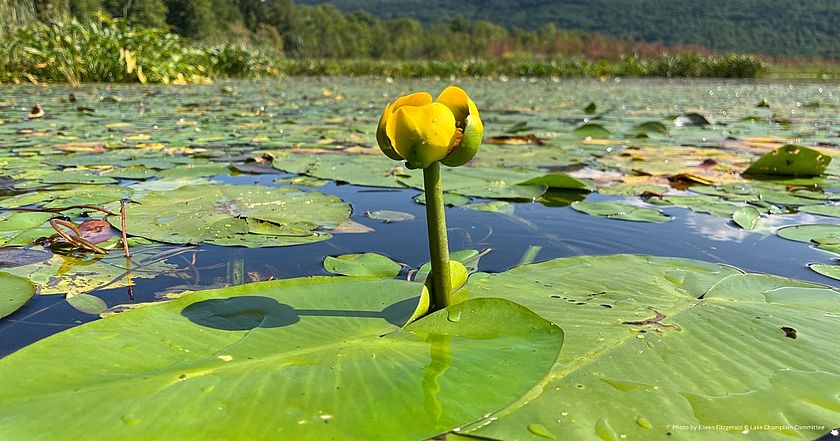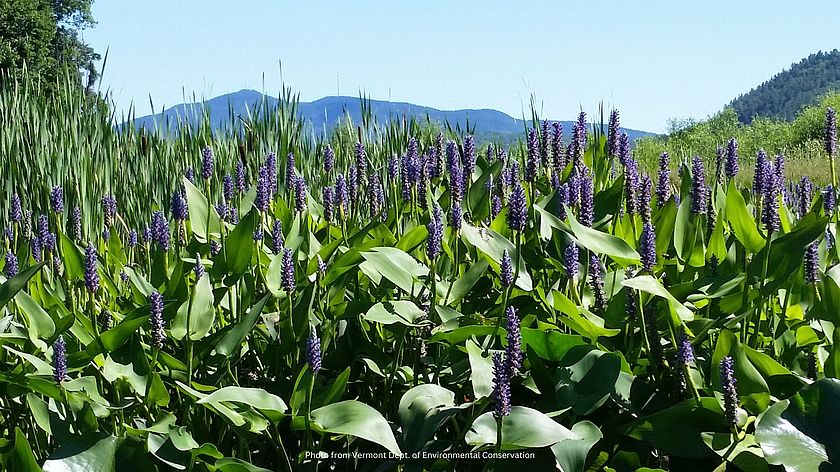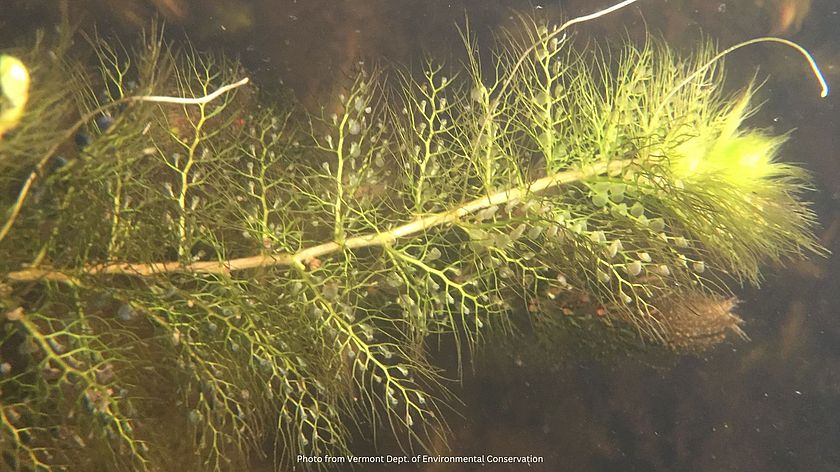Lake Look: A Brief Natural History of Aquatic Plants
LCC Summer's End 2024 E-News
Aquatic plants in Lake Champlain will be dying back soon, but their blooms provide additional color to the vibrant autumn landscape. How did aquatic plants in the lake get there, and what helps make them successful away from land? We dig into the origin of plants, their journey from water to land and back again, and some specific adaptations of plants found in the Lake Champlain basin.

The origins of plants
We start nearly one billion years ago in an ocean teeming with cyanobacteria, the first photosynthetic life on earth. These are the same cyanobacteria that bloom in Lake Champlain and other waterways. At some key moment in this ancient ocean, a single-celled protozoan engulfed one of the cyanobacterium, but instead of digesting it , the two began to work together. In this symbiosis, the cyanobacteria provided food while the protozoan provided protection and structure. This team became the first ever plastid, which is the ancestor to all plants and algae on earth.
Plants’ land invasion
The plastids remained in the ocean for some time, developing and diversifying into more complex forms of algae. Land was an elusive frontier until moss evolved with the ability to dry out, rehydrate, and continue to survive. This gave plants some leeway to live on land, where they developed more complex structures to store water and spread out. The proliferation of plants helped oxygenate the atmosphere and make life on earth possible.
The return to water
Aquatic plants are vascular plants, which developed on land and evolved to go back into the water, similar to how dolphins and whales came to be. These aquatic mammals gradually developed the traits that behooved life in water but are different from fish that evolved entirely in the water. The same distinction can be drawn between aquatic plants that we’re familiar with and the algae that evolved entirely in water: aquatic plants as we know them are land plants that gained special traits to succeed in and on the water.
Pond lily
To highlight a few aquatic plants, we’ll start with the classic pond lily. Pond lilies (Nymphaeales) are one of the oldest flowering plants on earth: their fossil record dates to the early Cretaceous period (about 125 million years ago). This was a time when dinosaurs roamed and simple non-flowering plants carpeted the landscape: ferns, horsetails, and smaller coniferous trees. In the water, however, plants were starting to develop flowers and exposed seeds—called angiosperms. The first among them were pond lilies. Their Cretaceous form was partially like what we see today: they had large leaves that floated on the water’s surface. The flowers, however, were considerably smaller—and among the first true flowers on earth. Now, there are 70 species of Nymphaeales, about seven of which are native to the Lake Champlain Basin, including yellow pond lily (Nuphar variegata), the blooms of which are still visible as autumn unfolds.

Pickerelweed
Pickerelweed (Pontederia cordata) can also still be seen blooming through September. They evolved a rare trait called tristyly, which means that their flowers take on three unique forms. The main distinction between the three types has to do with the proportions of the reproductive structures within the flower, so to us they may all look the same, but to a pollinator who gets “under the hood” of the flower, they are quite different. The reason for this is to prevent self-fertilization, which promotes genetic diversity within the species. The showy purple flowers emerge above the surface of the water and attract pollinators such as bumblebees and butterflies. Each individual plant will have one of the three floral shapes. The different flower forms make it unlikely for the pollen of one flower to wind up within the same plant or within a flower of the same morph, so a smattering of the three flower shapes will be spread out in a single population of the plant.

Bladderwort
Common bladderwort (Utricularia vulgaris) is a carnivorous plant that lives submersed in the water and is native to Lake Champlain. Carnivory stretches our common perception of plants as peaceful photosynthesizers. This trait evolved in plants independently at least a dozen times, so bladderworts are not necessarily closely related to plants like the Venus flytrap. Unlike the two large leaves that form a “mouth” for the Venus flytrap, bladderwort leaves are interspersed with tiny sacs that trap and digest prey. The bladder trap, when "set", is under negative pressure in relation to its environment. The trap opens when hapless prey such as insect larvae or other minute aquatic organisms bump against the fine microscopic hairs around the bladder. This mechanically triggers the bladder to open and suck in water and whatever is floating in it. Once the bladder is full of water, the trap closes. The whole process from trigger to re-sealing the bladder takes about 10 milliseconds--100 times faster than a Venus flytrap--and water is sucked in at a remarkable force of 600 g (or 600 times the force of gravity). According to the Guinness Book of World Records, this makes the bladderwort the fastest plant in the world! Advances in microscopy and high-speed cameras have allowed researchers to study this surprisingly sophisticated trap system more closely. Recent findings suggest that bladderworts may form symbiotic relationships with microorganisms around their bladders, possibly to help attract prey and assist with digestion (much like our own gut flora!).
Lake Champlain’s native aquatic plants have a storied natural history as they adapt to ongoing evolutionary pressure.
The Lake Champlain Committee (LCC) has a roving native aquatic plant art show that includes fact sheets and large display photos of 15 native aquatic plants from arrowhead to yellow pond lily – perfect for art galleries and local libraries. Please contact us at lcc@lakechamplaincommittee.org or 802 658-1414 if you’d like to help arrange a showing in your community.
